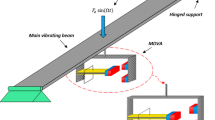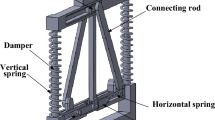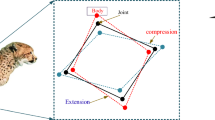Abstract
The most important thing in haptic interaction with mobile devices is to create vibrotactile sensation with wide frequency range. However, it is not easy to generate vibrotactile signal with wide frequency range with conventional vibrotactile actuators. Therefore, this paper presents a miniature impact type actuator, which has wide enough frequency range to selectively stimulate mechanoreceptors, consisting of a mass, an elastic spring, a housing, and a solenoid. To create strong impact force in wide frequency range in real-time, we adopt an unstable structure. Due to the impact with fast rising and falling time in the proposed vibration actuator, strong impact vibration can be created over wide frequency range. We simulate the magnetic flux line of the proposed actuator and magnetic force applied to the mass using an FEM simulation tool. We carry out an experiment in order to investigate the response time of the proposed actuator. Another experiment is conducted to show that the proposed actuator can create sufficient output force to stimulate human skin over a wide frequency bandwidth and can convey a variety of vibrotactile sensations to users.
Similar content being viewed by others
References
D. S. Kwon and S. C. Kim, “Haptic interfaces for mobile devices: a survey of the state of the art,” Recent Patents on Computer Science 2008, vol. 1, no. 2, pp. 84–92, 2008. [click]
J. Kang, J. Kook, K. Cho, S. Wang, and J. Ryu, “Effects of amplitude modulation on vibrotactile flow displays on piezo-actuated thin touch screen,” International Journal of Control, Automation, and Systems, vol. 10, no. 3, pp. 582–588, 2012.
Y. Nakagawa, A. Kamimura, and Y. Kawaguchi, “Mimic-Tile: a variable stiffness deformable user interface for mobile devices,” Proc. of the SIGCHI Conference on Human Factors in Computing Systems, pp. 745–748, 2012.
S. Brewster, F. Chohan, and L. Brown, “Tactile Feedback for Mobile Interactions.” Proc. of ACM CHI 2007, San Joes, CA, pp. 159–162, 2007.
J. Kangas, D. Akkil, J. Rantala, P. Isokoski, P. Majaranta, and R. Raisamo, “Gaze gestures and haptic feedback in mobile devices,” Proc. of the SIGCHI Conference on Human Factors in Computing Systems, pp. 435–438, 2014. [click]
I. Hwang, H. Lee, and S. Choi, “Real-time dual-band haptic music player for mobile devices,” IEEE Transactions on Haptics, vol. 6, no. 3, pp. 340–351, 2013. [click]
http://www.immersion.com/products/touchsense-tactilefeedback/4000-series/index.html
S. D. Kweon, I. O. Park, Y. H. Son, J. Choi, and H. Y. Oh, “Linear vibration motor using resonant frequency,” US PATENT no. 7,358,633 B2.
Q. S. Pan, L. G. He, C. L. Pan, G. J. Xiao, and Z. H. Feng, “Resonant-type inertia linear motor based on the harmonic vibration synthesis of piezoelectric bending actuator,” Sensors and Actuators A, vol. 209, pp. 169–174, 2014. [click]
Y. J. Cho, A Smart Actuator based on Electrodynamics and Piezoelectric Effect for Haptic Feedback, Master’s Thesis, KAIST, 2011.
R. J. Wood, E. Steltz, and R. S. Fearing, “Optimal energy density piezoelectric bending actuators,” Sensors Actuators A, vol. 119, pp. 476–88, 2005. [click]
I. Poupyrev, S. Maruyama, and J. Rekimoto, “Ambient touch: designing tactile interfaces for handheld devices,” Proc. of ACM Symp. on User Interface Software and Technology, 2002. [click]
M. Wagner, A. Roosen, H. Oostra, R. Hoppener, and M. D. Moya, “Novel low voltage piezoactuators for high displacements,” J. Electroceram, vol. 14, pp. 231–238, 2005. [click]
http://www.lginnotek.co.kr/product/vibration_motor.jsp
S. Colin, P. Seppo, and V. Arto, “Medium fidelity rapid prototyping of vibrotactile haptic, audio and video effects,” Proc. of IEEE Haptic Symposium, pp. 23–26, 2014. [click]
G. M’boungui, B. Semail, F. Giraud, and A. A. Jimoh, “Development of a novel plane piezoelectric actuator using Hamilton’s principle based model and Hertz contact theory,” Sensors and Actuators A vol. 217, pp. 116–123, 2014. [click]
R. S. Johansson, and A. B. Vallbo, “Tactile sensibility in the human hand: relative and absolute densities of four types of mechanoreceptive units in glabrous skin,” Journal of Physiology, vol. 286, pp. 283–300, 1979. [click]
L. Kruger, M. Friedman, and E. Carterette, Pain and Touch, Elsevier, 1996. [click]
Author information
Authors and Affiliations
Corresponding author
Additional information
Recommended by Associate Editor Kang-Hyun Jo under the direction of Editor Fuchun Sun. This research was supported by the Basic Science Research Program through the National Research Foundation of Korea (NRF) funded by the Ministry of Education, Science and Technology (grant number: NRF-2015R1D1A1A01059649) This work was also supported by the ICT R&D program of MSIP/IITP [R0101-15-0034, Development of tactile information storing and playing platform based on flexible sensors for immersible media].
Tae-Heon Yang received the B.S. degree in Mechanical Engineering from Yonsei University, Seoul, Korea, in 2006, and the M.S. degree (2008) and the Ph.D. (2012) in Mechanical Engineering from Korea Advanced Institute of Science and Technology (KAIST), Daejeon, Korea. He is currently a senior research scientist at Korea Research Institute of Standards and Science (KRISS), Daejeon, Korea. His research interests include Cardiovascular Simulators, Haptics (tactile actuator, tactile sensor and haptic interface), polymer devices (electroactive polymer and pressure resistive material), and national measurement standards of pressure and vacuum.
Dongbum Pyo received the B.S. degree in Mechanical Engineering from Korea University, Seoul, Korea (2010) and the M.S. degree in Robotics Program from Korea Advanced Institute of Science and Technology (KAIST), Daejeon, Korea (2012). He is currently a Ph.D. student in Mechanical Engineering at Korea Advanced Institute of Science and Technology (KAIST), Daejeon, Korea. His current research interests include Haptics (tactile actuator, haptic interface, and haptic rendering), and Human-Cumputer-Interaction.
Sang-Youn Kim received the B.S. degree from Korea University, Seoul, Korea and an M.S.E (1996) and a Ph.D. (2004) in mechanical engineering at Korea Advanced Institute of Science and Technology (KAIST). He was a researcher in Virtual Reality Research Center in 2002. From 2004 to 2005, he was a researcher at HumanWelfare Robot System Research Center. In 2005, he was a research staff member at Samsung Advanced Institute of Technology (SAIT). He is currently an assistant professor of internet-media engineering at Korea University of Technology and Education. His current research interests include Human-Computer Interaction, 3D object modeling, Virtual Reality, and Haptics (haptic actuator, tactile display).
Dong-Soo Kwon received the B.S. degree from Seoul National University, Seoul, Korea, in 1980, the M.S. degree from the Korea Advanced Institute of Science and Technology (KAIST), Daejeon, Korea, in 1982, and the Ph.D. degree from the Georgia Institute of Technology, Atlanta, in 1991, all in mechanical engineering. From 1991 to 1995, he was a Research Staff Member with Oak Ridge National Laboratory. He is currently a Professor of mechanical engineering, the Director of the Center for Future Medical Robotics, the Director of the Human Robot Interaction Research Center, KAIST. He is a member of the IEEE RAS AdCOM, the Korean Society of Mechanical Engineers and the International Council of Associations for Science Education. His current research interests include human–robot/computer interaction, medical robots, telerobotics, and haptics.
Rights and permissions
About this article
Cite this article
Yang, TH., Pyo, D., Kim, SY. et al. Development and evaluation of an impact vibration actuator using an unstable mass for mobile devices. Int. J. Control Autom. Syst. 14, 827–834 (2016). https://doi.org/10.1007/s12555-014-0490-9
Received:
Accepted:
Published:
Issue Date:
DOI: https://doi.org/10.1007/s12555-014-0490-9




